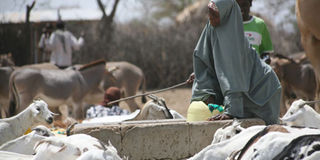Govt team out to assess Kenya's famine situation

HEZRON NJOROGE | NATION. Women draw water from a communal watering point at Habaswein in Wajir south recently. More than 150,000 people in Northern Kenya are at risk of starvation.
Six Permanent Secretaries and an assistant minister Thursday led a strong government delegation to assess the famine situation in the country following the death of at least five people from starvation.
The team toured Sololo, Chelbi, Moyale and Garissa districts in Eastern and North Eastern provinces, the pastoral areas hard hit by the ravaging drought.
At the Kenyatta International Conference Centre, another team of technocrats held a crisis meeting as the government flexed its muscles to end further deaths due to starvation.
The team that went of Nairobi consisted of Permanent Secretaries Andrew Mondoh (Special Programmes), Lawrence Lenayapa (Development of Northern Kenya and other Arid Lands), Kenneth Lusaka (Livestock) and Dr Romano Kiome (Agriculture).
Others in the team were water PS David Stower, his Internal Security counterpart Francis Kimemia and Special Programmes assistant minister Muhamud Ali.
The Cabinet on Wednesday outlined several measures to tackle the looming famine setting in motion the flurry of activities witnessed on Thursday.
Among the measures the Cabinet outlined to mitigate the situation were buying of livestock from communities in drought-hit areas as well as providing funds to buy additional foodstuffs to supplement the stocks at the National Food Relief and the Strategic Grain Reserve programmes.“The Cabinet committee will also work out requirements for the livestock off take program to minimise losses that pastoralists may suffer,” a statement that came after cabinet meeting stated.
The statement also directed the Ministries of Agriculture and Livestock to give a comprehensive account of the resources which were spent on similar programmes last year, as these expenditures were intended to be managed on a revolving basis.
The Cabinet formed a Food Security Committee to work out details of the additional food requirements, especially for the vulnerable members of the population.
However, despite acknowledging the looming effects of the drought, the Cabinet was adamant that there are adequate provisions to deal with the immediate food shortages through the National Food Relief and the strategic grain reserve programmes.
National disaster
Relief organisations including the Kenya Red Cross Society and some MPs have asked President Kibaki to declare the famine a national disaster.
Speaking to the Nation on phone, Livestock PS said the team identified water as the most critical thing that the pastoral communities need.
“The body condition of the animals is not too bad but the most critical thing that we are seeing now is water,” said Mr Lusaka.
During the last drought in 2008, the Ministry of Livestock received Sh1.098 billion from the exchequer for the livestock off take programme.
However the amount is likely to go up this year with Mr Lusaka putting the figure at Sh1.5 billion.
“The last drought we received Sh1.098 billion but we want Sh1.5 billion this time,” he said.
At the time, the ministry also received Sh200 million as revolving fund for the off take programme. The funds were channelled through Agriculture Finance Corporation (AFC).
Farmers, both large-scale and traders accessed this fund from AFC as loans but since then, Mr Lusaka said only Sh75 million has been recovered and which is available for borrowing.
The overall intention of the off take programme will be to ensure that the affected communities are cushioned against the potential economic loss that may arise from the effect of the drought and that the country does not lose these animals.




